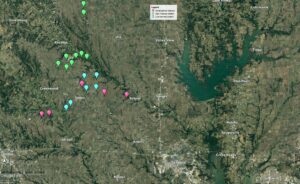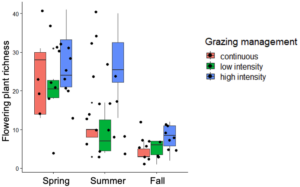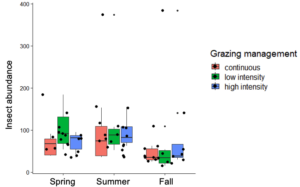Progress report for OS23-162
Project Information
The purpose of this project is to quantify the contributions to pollinator conservation of different grazing management strategies. Pollinators are critical for healthy rangelands. They enable production of food for both people and livestock, and help maintain healthy water and soil (Black et al. 2011). While bees are the most important pollinators in many grasslands, other insects including beetles, flies, butterflies, and moths make significant contributions (Hanberry et al. 2021; unpublished data). Rangelands cover almost a third of the US land area with largely natural land (Havstad et al. 2007). Thus, they have strong potential to support pollinator biodiversity by providing critical food (e.g., pollen, nectar, larval host plants) and shelter (e.g., bare ground for ground nesting species, woody cavities, pithy stems) habitat. Indeed, state and national initiatives target grassland management as critical for pollinator conservation (e.g., Pollinator Health Task Force 2015; USDA 2021). However, extensive overgrazing, and conversion to row crops or developed areas, have degraded rangeland habitat.
One management strategy that aims to increase grazing sustainability is rotational grazing. This strategically incorporates periods of rest to enable plant regeneration, and distributes cattle impacts across the entire landscape rather than a small number of preferred locations. Compared to continuous grazing, rotational grazing can reduce soil compaction, decrease erosion, increase soil carbon storage, and improve cattle forage availability and quality (Teague et al. 2011; Byrnes et al. 2018; Harmel et al. 2021). Two common rotation categories are high and low intensity. The former is often referred to as high-intensity, low-rotation or adaptive multi-paddock grazing. High-intensity rotation seeks to mimic historic bison grazing by frequent rotation of cattle herds among many smaller paddocks. Each paddock receives several months of rest after a short period (often several days) of intense grazing. Low-intensity rotation includes the Merrill system (three herds rotated among four pastures), the switchback system (one herd, two pastures), and many variations that involve rotating among pastures every few months. Research to date on the sustainability of rotational grazing has focused almost entirely on cattle forage and production. However, rangelands as functional ecosystems must support diverse ecosystem functions and services, in addition to meeting production goals.
There is a particular need to study grazing impacts on pollinators. The properties of ranchland that are most sensitive to management – vegetation cover and composition, and soil structure (Havstad et al. 2007) – are the same properties that determine the fate of many pollinators. Thus, while ranchlands have high potential to support pollinator conservation, this can only be achieved through increased understanding of how specific management strategies affect pollinators and the resources that support them. This project will advance this goal by determining how adoption and intensity of rotational grazing, impacts pollinator habitat – including food and shelter resources – and communities.
To determine how grazing management contributes to pollinator conservation, it is necessary to (1) quantify pollinator communities on ranchland and (2) determine relationships among grazing management, specific food and shelter resources, and pollinators. There is great opportunity for sustainability-oriented grazing strategies to promote beneficial insects. Determining pollinator occurrence and the underlying mechanisms, in relation to specific management strategies, is essential to meet this goal. It is also critical to determine how grazing management simultaneously affects pollinators and livestock.
Cooperators
- - Producer
- - Producer
- - Producer
Research
In 2023 we quantified pollinators and their resources at eight sites maintained through high-intensity rotational grazing by the Dixon Water Foundation, (b) five continually grazed control sites, and (c) six sites managed through low-intensity rotational grazing (Fig 1). This expanded number of sites will provide more robust results. At each site, the rancher cooperator follows their typical management; this project does not necessitate any management changes. To quantify management, we are digitizing grazing charts from cooperators who provide them.

At each site we established eight 90m transects that radiate out from a central point. Sampling along these transects enables capturing spatial heterogeneity within a site. In 2023 we sampled pollinators, flowering plants, ground cover, and forage production (biomass) using methods successfully piloted in 2021 and 2022. We sampled pollinators and vegetation during each of Texas’ main bloom periods (spring, summer, fall), and biomass in the dormant season (December). Sampling for two years will improve results, because insect and plant communities show inter-annual variation.
We sampled pollinators through passive trapping (pan traps, and blue vane traps that target larger bees, deployed for 24 hours per site per season) and active netting of insects on flowers along the transects (45 minutes in the morning and afternoon). All insects were pinned and identified in the lab, to calculate abundance and diversity (e.g., richness) for each site. We measured food and shelter resources via a quadrat method commonly used by pollination ecologists. We placed a 1x1m quadrat at six locations along each transect: 15m, 30m, 45m, 60m, 75m, and 90m from the center of the site (thus, 48 quadrats per site per season). In each quadrat we identified all plant species currently in flower, counted the number of flowers of each species, measured vegetation cover (separately quantifying green grass, green forbs, senesced vegetation, and open canopy), and measured ground cover (separately quantifying bare ground, litter, stems, rocks, and wood such as tree trunks). We used these data to estimate total floral abundance and richness, relative cover by different vegetation types, and the proportion of the ground that is suitable for different insect shelter types (ground, litter, etc.) at each site. We vouchered all flowering plant species at each site by uploading detailed photos to an iNaturalist project that the lab maintains. We measured biomass by clipping all vegetation within a standard area, drying the vegetation, and weighing it. We placed a 0.5x0.5m quadrat 100m from the site center along four transects per site. At each location we cut and collected all vegetation occurring within the box defined by the quadrat. To better estimate potential pollinator shelter resources we separately collected standing matter (connected to the ground) and loose litter from within each quadrat. In the lab we measured dry weight.
We will first determine whether the pollinator communities or available resources systematically differ among grazing management strategies. This will indicate whether each strategy can promote pollinators. We will then use linear regression and multivariate indicator analyses to determine which types of resources affect pollinator community diversity, and specific pollinator species. This will identify habitat elements that are most important for pollinator conservation, and that are useful indicators of habitat quality. Because sustainable ranching must support both livestock and diverse wild animals, we will also compare pollinator communities and important habitat elements to forage production at each site. This will provide an initial assessment of whether there are strong trade-offs between livestock production and biodiversity conservation.
In 2023 we found 316 flowering plant species and collected 4,663 insect specimens across 19 ranch sites. Adjusting for the number of ranches sampled in each management category, this included 19.6 plant species (147.6 flowers in quadrats) per site at continuously grazed sizes, 14.8 plant species (130.8 flowers) per site at ranches using low-intensity rotation, and 16.1 plant species (329.25 flowers) per site at ranches using high-intensity rotational grazing (Fig. 2). We collected an average 187 insects per site at continuously grazed ranches, 277.7 at ranches using low-intensity rotation, and 257.8 at ranches using high-intensity rotation (Fig. 3). We are currently identifying insects in order to calculate insect diversity. For insects that were identified by the end of 2023, we consulted with experts at the Texas A&M University Insect Collection Open House (Jan. 2024) to verify identifications. Winter biomass density averaged 753.5 g/m2 on continuously grazed ranches, 803.3 g/ m2 on ranches using low-intensity rotation, and 979.7 g/ m2 on ranches using high-intensity rotation. Continuing to collect data in 2024 and identifying all insect specimens will provide a clear picture of pollinator communities on ranchland and relationships among grazing management, specific food and shelter resources, and pollinators.


Educational & Outreach Activities
Participation Summary:
We will disseminate results from this project through oral and written presentations to ranchers, land managers, and academics. Outreach to ranchers and land managers will leverage existing activities organized by the Dixon Water Foundation, adding a component on managing rangelands for pollinator conservation. The Dixon Water Foundation regularly supports local ranchers through customized demonstrations, field days, and workshops. We will develop materials that disseminate our results during these events.
- On-ranch field day – The Dixon Water Foundation routinely hosts workshops on sustainable ranching for ranchers, NRCS staff, conservationists, Master Naturalists, and other groups. We will discuss this project during a workshop organized by the Native Prairie Association of Texas, whose members include ranchers. Attendees will learn about pollinator habitat requirements and conservation on ranches, and will be presented with the rationale for the project, methods and results, and implications for ranch management. Participants will be able to see pinned pollinator specimens (item 4) and photos of pollinator-friendly habitat. A handout in both English and Spanish (item 2) and poster (item 3) will be available.
- Handout and talking points for Dixon Water Foundation staff to use – We will provide talking points, based on the field day presentation, to Dixon Water Foundation staff. They will incorporate these talking points into presentations to and conversations with ranchers. We will also create a handout with project results. This handout will be available at our presentation, as well as additional field days and workshops run by the Foundation. It will also be posted on the Dixon Water Foundation’s website for use by a broader ranching community.
- Pollinator conservation poster – We will design and print a poster that promotes pollinator conservation and includes results of this study. This poster will be on display at the Josey Pavilion at the Dixon Water Foundation’s North Texas ranch and the main office at the West Texas ranch. Events hosted by the Foundation occur largely at these two buildings. In West Texas we will provide one poster in English and one in Spanish.
- Pollinator display collection – We are making two displays that include pinned specimens of diverse flower-visiting insects, with educational labels. Insects come from surplus material collected by students in UNT’s Insect Ecology course and the Sam Houston State University Natural History Collections, and thus will not require collection of extra individuals. In October 2023 we previewed a preliminary version of the display box at a Ranching for Resilience Workshop hosted by the Dixon Water Foundation, where it generated significant interest.
- Plant identification guide – Due to interest by ranchers and NRCS staff, we published the lab’s local plant guide for non-experts through the lab website.
- Peer-reviewed publications – We anticipate one publication in a peer-reviewed journal such as Rangeland Ecology & Management or Environmental Entomology.
- Conference presentations – A graduate student presented research results and conclusions at the Entomological Society of America 2023 annual meeting. PI Lichtenberg and a graduate student will present additional results in 2024.
Learning Outcomes
General pollinator information
Project Outcomes
This project addresses the issue of providing beneficial insect habitat in agriculture. Through quantification of pollinators and their resources on ranches, we aim to show how grazing management affects pollinator conservation. Pollinator conservation, in turn, increases agricultural sustainability by improving environmental quality, enhancing quality of life, and, in some cases, helping sustain economic viability of ranches. Sustainable ranching relies on nature to provide livestock forage. Pollinators underlie processes such as plant reproduction, soil nutrient cycling, and water filtration that sustain forage production. Because of this keystone role, the results of this project will provide a missing link needed to reimburse ranchers for the value created by healthy rangelands, in addition to determining how specific management strategies (high- and low-intensity rotational grazing) affect a conservation priority group.
By quantifying rotational grazing’s impacts on pollinator communities and determining relationships among grazing management, forage production, specific resources, and pollinators this project will provide critical information for advancing grazing sustainability. It will provide the data necessary to conserve pollinators, and thereby support additional ecosystem services, and to compensate ranchers for the services that their ranches provide to society.
Information Products
- Synergies and tradeoffs in conserving diverse pollinators: a traits-based approach (Conference/Presentation Material)
- Lichtenberg Lab Plant Field Guide (Manual/Guide)